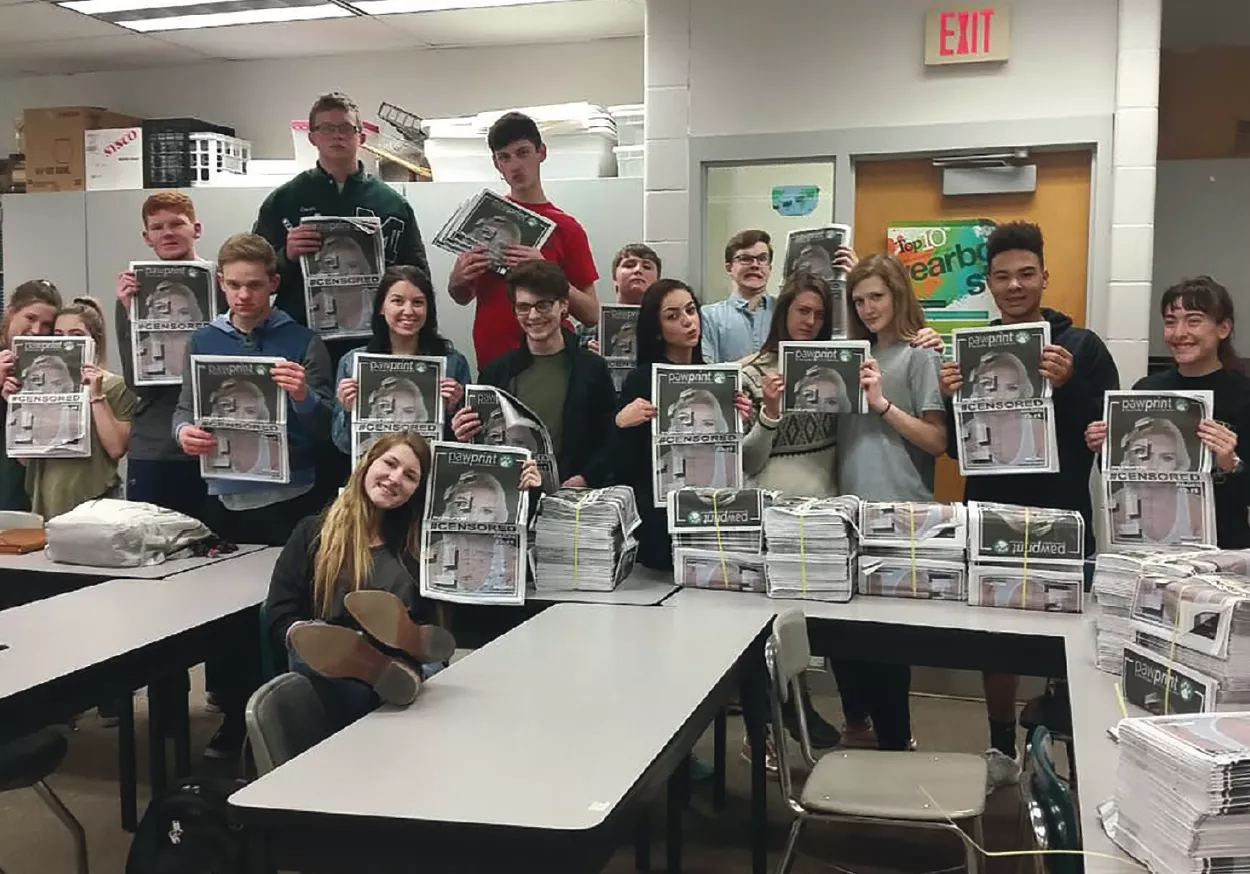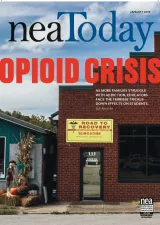Student journalism is more popular than ever
Student journalists at Clayton High School, outside St. Louis, took a hard look at football-related brain injuries this fall, asking questions like, “Why do we still play football? What do we know about what it does to people’s brains?” and interviewing players, athletic directors, and a concussion expert at Vanderbilt University.
This followed a cover story on designing a “more perfect school,” based on what scientists know about sleep, exercise, and learning science, and preceded a deep dive into post-surgical pain medications that sometimes may lead young people to heroin addictions.
These aren’t easy times to be journalists. Recent polls show one in three Americans can’t name any of the rights guaranteed by the First Amendment, and more than a third of Republicans think “press freedom does more harm than good.” From the White House, President Donald Trump recently tweeted that “a large percentage of the media” is “the enemy of the people,” and his staff recently attempted to strip a CNN reporter of his press credentials.
And yet, the students at Clayton High School are doubling down on journalism. Never in her tenure have more students been involved in their award-winning print and online news outlets, says journalism advisor Erin Sucher-O’Grady. “We have about 850 students in the whole school—it’s a relatively small public school—and I have about 100 students involved in the Globe and the website,” says Sucher-O’Grady.
And it’s not just Clayton High School. College applications to notable journalism schools are up—24 percent at Northwestern University, for example. At the University of Maryland this year, the incoming class in the journalism college is 50 percent bigger than last year. “Every time [Trump] calls journalists the ‘enemy of the people,’ or says something about ‘fake news,’ or gets a crowd at a rally to jeer at the White House press corps,” Maryland journalism dean Lucy Dalglish told the Washington Post, more students decide “they’re going to major in journalism.”
This isn’t the first time that current events have inspired a flood of journalism students. In 1972, Washington Post journalists Carl Bernstein and Bob Woodward captivated the nation with their investigation of a corrupt White House.
Then, like now, newsrooms bulged with a generation of young people seeking to change the world.
Today’s headlines—from climate change to police shootings to federal shenanigans—carry a similar message, that the work of a free media is critical and necessary to a Constitutional democracy. “We’re in a sort of singular moment, in the way that I perceive happened after Watergate, where we understood that it’s an important civic responsibility to do this work,” says Sucher-O’Grady.
“There is a sentiment that America needs journalists.” Even as journalism students are energized by current events, their studies aren’t the same as they were in 1972. Consider the rise of “fake news,” or news articles that are wholly made up and published on the internet. In 2016, about one in four Americans visited a fake-news website during a five-week period, according to a Princeton University study that tracked the internet movements of willing participants. A more recent study found
that fake news travels faster on Twitter than actual truthful news.
“My students wonder what their role is in fighting this: What do they do? I tell them their main role is not to pass it on!” says Dennis Swibold, a professor of journalism at the University of Montana in Bozeman.
But fighting fake news shouldn’t be the job of journalism teachers only, says Swibold. “We’re talking information literacy here, and I don’t care if you’re a scientist or an economist, you have to care about being able to find credible information. If truth is under attack, it’s not just journalists who should be worrying.
“I asked my class of 20 today, and only three or four say that ‘maybe’ they had any training in information literacy,” says Swibold. “This has to be a broad push through education.”
Paul Aubrey, a journalism teacher at North Kansas City High School in Missouri, agrees.
“We’re talking information literacy here, and I don’t care if you’re a scientist or an economist, you have to care about being able to find credible information. If truth is under attack, it’s not just journalists who should be worrying.”
—Dennis Swibold, Professor of Journalism, University of Montana, Bozeman
“My students talk about this from day one. We look at news stories and talk about how to recognize real news,” he says.
But the issue is bigger: “It’s not just about teaching kids to be student journalists, it’s about teaching all students to be skeptical consumers of information,” says Aubrey. “My personal opinion is that it should be required of all students.”
Meanwhile, more than ever, journalism teachers are talking about truth and accuracy. “We talk a lot in our law and ethics unit about anonymous sources and what they do to the public’s trust of news outlets. Journalists will use anonymous sources when that source is afraid they’re going to lose their job, or when they’re afraid they might come to financial or legal harm because of talking,” says Aubrey. “But I don’t think news outlets are good at explaining why they use anonymous sources, and it breeds distrust.”
Future Woodwards
On Sucher-O’Grady’s staff at the Globe, she might have a future Bob Woodward or Gwen Ifill, or she might not. Over the years, a few of her former students have landed at local newspapers, but being a student journalist doesn’t necessarily mean you’ll be a working one someday.
And that’s okay.
“I tell students and families that I know the majority of students entering this space aren’t going to be journalists in their future professions,” says Sucher-O’Grady.
“The things I really care about are transferrable into any field—the having a conversation with somebody you don’t know and having that person walk away and say, ‘That was professional,’ the writing skills obviously are useful, and also the leadership skills. This is a student-run publication by our school board policy—kids are in the drivers’ seat—and so we talk about how upperclassmen need to mentor and coach the underclassmen who will someday take their place.”
And, even if they’re not future news reporters, they hopefully will always be news readers or consumers, says Aubrey.
“Yes, we teach content. But we also are teaching kids how to function in our political system. For democracy to work, we have to have a well-informed citizenry,” says Aubrey. “My number-one goal as a journalism teacher is to make sure the students who come through my door will learn how to become well-informed citizens of our democracy.”
The New Voices Act
The Movement to Protect Student Journalists
In September, the student newspaper at Vermont’s Burlington High School reported a guidance counselor had been charged by the state with six counts of unprofessional conduct. One day later, the school’s interim principal ordered student journalists to remove the article. They refused—and the article remains online today.
But in Pennsylvania, a student editor says her principal suppressed about a dozen articles, including a front-page story about marijuana use and an editorial about the district’s mishandling of students’ sexual assault complaints.
The difference? Vermont—and not Pennsylvania—is among 14 states with laws to protect student journalists from censorship.
In recent years, the nationwide New Voices campaign, led by the nonprofit Student Press Law Center (SPLC), has sought to expand protections for student journalists. Last year, it helped introduce bills in eight states. In March, a New Voices Act became law in Washington.
In states that pass New Voices, lawmakers nullify the effects of the 1988 Supreme Court ruling in Hazelwood v. Kulhmeier, which allows principals with “legitimate pedagogical reasons” to censor student journalists. Since then however, principals have used Hazelwood as cover to kill articles about hazing in school sports, un-safe conditions in school facilities, and other embarrassing reveals. “It is a mentality that the paramount concern of school governance—more important than effective teaching and learning—is to get through a day without controversy,” writes SPLC Executive Director Frank LoMonte.
In Paul Aubrey’s classroom, principals haven’t censored anything that he recalls—but the threat of censorship still impacts his students’ thinking. “They’ll come up with an idea and then say, ‘Oh, they’ll never let us do that!’ and abandon it,” he says.
“Administrators are very concerned with image, and they want all the news about a school to be positive. And most student publications are very positive because students are proud of their school for the most part,” says Aubrey. “But there are problems everywhere and the point of journalism is to shine a light on those problems. If you’re not allowed to practice that as a high school journalist, you start to believe you have to give in, that you can’t fight power.”
That’s not the right lesson for student journalists to practice, he says.



